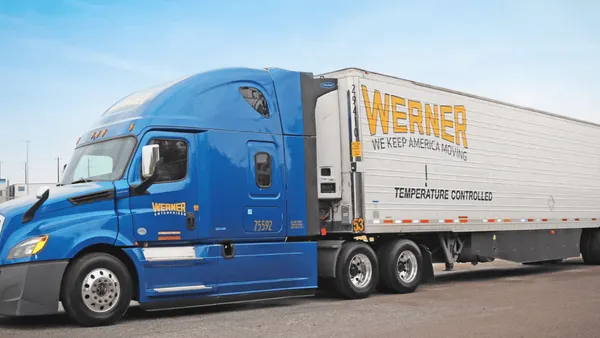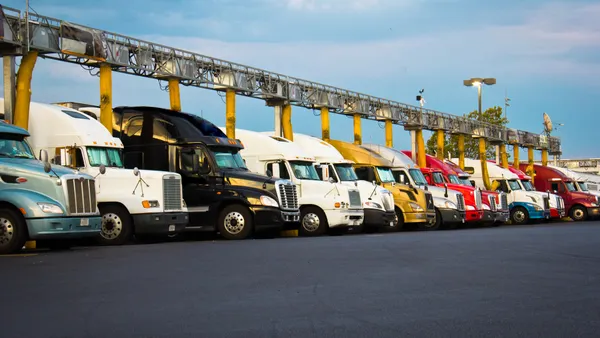Dive Brief:
- Trucking revenues were down 17.2% in Q2, compared to the same quarter in 2019, according to a Friday report by the U.S. Census Bureau. The bureau estimated that trucking brought in $59.8 billion in revenue in Q2, down from $72.2 billion in Q2 2019. On a wider scale, transportation and warehousing revenue dropped 31% YoY.
- Policies implemented to combat COVID-19 took effect in the late part of Q1, but it wasn't until Q2 that the economic damage really set in. Revenues dropped 16.7% from Q1 to Q2, the bureau reported, when the industry raised $71.7 billion. Transportation and warehousing revenue in Q2 dropped 28.2% from Q1.
- The shape economic rebound will take is uncertain, with some federal officials hoping for a strong V-shaped recovery. On Friday, the Federal Reserve Bank of St. Louis forecast GDP growth of 20.2% in Q3, after a plunge of 32.9% in Q2, according to the Bureau of Economic Analysis. Both figures are on an annualized basis.
Dive Insight:
The revenue numbers indicate the severe effect of the pandemic-related shutdowns and COVID-19 countermeasures upon the trucking industry.
Initially, the panic buying caused a surge in freight, but once that subsided in April, the bottom was struck, said Tim Denoyer, ACT Research vice president and senior analyst. From there, the freight economy has slowly risen, and Denoyer estimated Q3 and Q4 will show progress toward the norm.
The federal coronavirus relief bill was one factor that has helped to lift the market. And with many people working from home or laid off, home renovations and shopping online became a priority, Denoyer said. That has driven the trucking economy back from the trough, he said, noting U.S. weekly spot rates are up 30% YoY. Consumers picked apart retail shelves through the summer, and that means retailers needed to ship via truck to replenish inventories. West Coast ports have begun receiving replacement freight, Denoyer said.
But trucking has not fully recovered from the economic damage, Denoyer said. From the beginning of the year, trucking employment is still down 75,000 jobs, he said.
And because of political uncertainty about a new federal relief bill, consumer spending may be flattening, some experts said. Others see troubling signs in stock performance.
Trading performance on Monday among seasonally sensitive trucking firms was poor, reflective of concern about decelerating growth in upcoming months, particularly among asset-based truckload carriers, wrote Benjamin Hartford, a senior equity research analyst for R.W. Baird, in a Monday report.
Hartford said freight cycle elements, including low inventories and limited supply growth, "render the peak cycle concerns that have emerged during [Q3 2020] premature. "That said, the reality of decelerating spot rate growth highlights the need for investors" to look at investing in companies that have freight contracts, including domestic intermodal and rails.
Dean Croke, DAT principal analyst, told Transport Dive this month that consumer-packaging data he had seen so far in September indicates a spending slowdown.
"There's been a change in buying habits," Croke said. "People are expressing concern about the pace of the economic recovery."
Trucking capacity, though, is expected to be tight well into 2021. The Council of Supply Chain Management Professionals reported a score of 31.5 in its Transportation Capacity Index in August. A reading above 50 indicates capacity expansion.
"This is the second-lowest score in the history of the LMI, indicating a significant contraction in available capacity," the report said. "Transportation Capacity will continue to be strained over the next 12 months, and that as a result, firms will have to utilize more of what is available."











